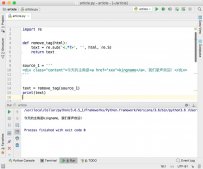IPV4正則表達式
Ipv4地址分為ABCDE五大類,其中ABC類是普通ip地址,D類是組播地址,E類保留,作為研究之用。
范圍分別為:
A: 1.0.0.1 ―一126.155.255.255
內網地址范圍:10.0.0.0 一一10-255.255.255
B: 127.0.0.1 —191.255.255.255
內網地址范圍:172.16.0.0——172.31.255.255
C: 192.0.0.1 —223.255.255.255
內網地址范圍:192.168.0.0—一192.168.255.255
D: 224.0.0.1 —239.255.255.255
E: 240.0.0.1 —255.255.255.255
我們的正則要求ip必須是ABC類地址。每個字節的第一個數字可以為0,比如說01, 001。
1. ip的第一個字節分作以下幾種情況:
1.長度為3且以2開頭,范圍為200-223
正則:22[0-3]丨2[0-1][0-9]
2.長度為3且以0或1開頭
正則:[0-1][0-9][0-9]
3.長度為1或2
正則:([0-9])]{1,2}
所以第一個字節的表達式為:
(22[0-3]丨2[0-1][0-9]|
[0-1][0-9][0-9]|
0[1 -9][0-9]|
([0-9])]{1,2})
2. 后面三個字節范圍為0-255,前面有一個點
分為以下幾種情況:
1. 以2開頭
正則:25[0-5]|2[0-4][0-9]
2. 以1和0開頭的情況和第一個字節相同。
所以,單個字節的正則表達式:
([.]
(25[0-5]|2[0-4][0-9]|
[0-1][0-9][0-9]|
0[1 -9][0-9]|
([0-9])]{1,2}))
3. 加上點號和重復三次,以及開始和結尾匹配符,IPV4最終正則表達式變為:
((22[0-3]丨2[0-1][0-9]|[0-1][0-9][0-9]|0[1 -9][0-9]|([0-9])]{1,2})([.](25[0-5]|2[0-4][0-9]|[0-1][0-9][0-9]|0[1 -9][0-9]|([0-9])]{1,2})){3})
點號之所以用中括號括起來是因為如果不擴起來是匹配任意字符。也可以用兩個反斜桿轉義。
加上行首和行尾匹配符:
(^((22[0-3]丨2[0-1][0-9]|[0-1][0-9][0-9]|0[1 -9][0-9]|([0-9])]{1,2})([.](25[0-5]|2[0-4][0-9]|[0-1][0-9][0-9]|0[1 -9][0-9]|([0-9])]{1,2})){3})$)
IPV6正則表達式
IPV6介紹
IPV6的長度是128位,相比于ipv4的32位,極大的擴展了ip地址可用空間。ipv4地址現在被視為一種稀缺資源,而ipv6地址相當充足,在可以預見的未來是用不完的。有這樣一段描述:如果地球表面(含陸地和水面)都覆蓋著計算機,那么IPv6允許每平方米擁有7*10A23個IP地址;如果地址分配的速率是每微秒100萬個,那么需要10A19年才能將所有的地址分配完畢。
IPv6地址表示
IPv6的128位地址通常寫成8組,每組為四個十六進制數的形式。比如:
AD80:0000:0000:0000:ABAA:0000:00C2:0002
是一個合法的IPv6地址。這個地址比較長,看起來不方便也不易于書寫。零壓縮法可以用來縮減其長度。如果幾個連續段位的值都是0,那么這些0就可以簡單的以::來表示,上述地址就可寫成:
AD80::ABAA:0000:00C2:0002
這個簡化只能用一次,在上例中的ABAA后面的0000就不能再次簡化。當然也可以在ABAA后面使用::,這樣的話前面的12個0就不能壓縮了。這個限制的目的是為了能準確還原被壓縮的0,不然就無法確定每個::代表了多少個0。例如,下面是一些合法的IPv6地址:
CDCD:910A:2222:5498:8475:1111:3900:2020
1030::C9B4:FF12:48AA:1A2B
2000:0:0:0:0:0:0:1::
0:0:0:0:0:0:12000:0:0:0:0::
同時每個段前面的零可以省略,因此
2001:0DB8:02de::0e13 等價于
2001:DB8:2de::e13
一個IPv6地址可以將一全IPv4地址內嵌進去,寫成IPv6形式和平常習慣的IPv4形式的混合體。
IPv6有兩種內嵌IPv4的方式:IPv4映像地址和IPv4兼容地址(已經被舍棄)。
IPv4映像地址
0000:0000:0000:0000:0000:ffff:192.168.89.9這種混合寫法對應的ipv6地址:
0000:0000:0000:0000:0000:ffff:c0a8:5909
其實表示的是192.168.89.9這個ipv4地址。IPv4映像地址布局如下:
0000…..0000(80bits)| FFFF | IPv4 address |
IPv4兼容地址
兼容地址和映像地址的區別就是第81-96位為0。
IPv4兼容地址布局如下:
0000…..0000(80bits) | 0000 | IPv4 address |
格式分為以下幾種情況:
1. 前面7個完整的字段,第8個字段為零壓縮寫法或者數字。如:
1:2:3:4:5:6:7:8
1:2:3:4:5:6:7::
對應的正則表達式為:
(([0-9A-Fa-f]{1,4}:){7}([0-9A-Fa-f]{1,4}{1}|:))
最外面加一層括號是為了保證與其他正則表達式拼接到一起時保證不產生混亂。
2. 前面6個完整的字段,后面2個字段可能為零壓縮寫法或者ipv4地址嵌入式寫法。如:
1:2:3:4:5:6::8
1:2:3:4:5:6::
1:2:3:4:5:6:192.168.1.1
對應的正則表達式為:
(([0-9A-Fa-f]{1,4}:){6}(:[0-9A-Fa-f]{1,4}{1}|((22[0-3]丨2[0-1][0-9]|[0-1][0-9][0-9]|0[1 -9][0-9]|([0-9])]{1,2})([.](25[0-5]|2[0-4][0-9]|[0-1][0-9][0-9]|0[1 -9][0-9]|([0-9])]{1,2})){3})|:))
3. 前面5個完整的字段,后面3個字段可能為零壓縮寫法或者ipv4地址嵌入式寫法。如:
1:2:3:4:5::
1:2:3:4:5::6
1:2:3:4:5::8
1:2:3:4:5::192.168.1.1
對應的正則表達式為:
(([0-9A-Fa-f]{1,4}:){5}(:[0-9A-Fa-f]{1,4}{1,2}|:((22[0-3]丨2[0-1][0-9]|[0-1][0-9][0-9]|0[1 -9][0-9]|([0-9])]{1,2})([.](25[0-5]|2[0-4][0-9]|[0-1][0-9][0-9]|0[1 -9][0-9]|([0-9])]{1,2})){3})|:))
4. 前面4個完整的字段,后面4個字段可能為零壓縮寫法或者ipv4地址嵌入式寫法。如:
1:2:3:4::
1:2:3:4::5
1:2:3:4::8
1:2:3:4::192.168.1.1
對應的正則表達式為:
(([0-9A-Fa-f]{1,4}:){4}(:[0-9A-Fa-f]{1,4}{1,3}|:((22[0-3]丨2[0-1][0-9]|[0-1][0-9][0-9]|0[1 -9][0-9]|([0-9])]{1,2})([.](25[0-5]|2[0-4][0-9]|[0-1][0-9][0-9]|0[1 -9][0-9]|([0-9])]{1,2})){3})|:))
前面3,2,1個完整字段的情況略。
8. 第一個字段即開始簡略寫法
::8
::192.168.1.1
對應的正則表達式為:
(:(:[0-9A-Fa-f]{1,4}{1,7}|:((22[0-3]丨2[0-1][0-9]|[0-1][0-9][0-9]|0[1 -9][0-9]|([0-9])]{1,2})([.](25[0-5]|2[0-4][0-9]|[0-1][0-9][0-9]|0[1 -9][0-9]|([0-9])]{1,2})){3})|:))
所以IPV6的正則表達式為:
(([0-9A-Fa-f]{1,4}:){7}([0-9A-Fa-f]{1,4}{1}|:))|
(([0-9A-Fa-f]{1,4}:){6}(:[0-9A-Fa-f]{1,4}{1}|((22[0-3]丨2[0-1][0-9]|[0-1][0-9][0-9]|0[1 -9][0-9]|([0-9])]{1,2})([.](25[0-5]|2[0-4][0-9]|[0-1][0-9][0-9]|0[1 -9][0-9]|([0-9])]{1,2})){3})|:))|
(([0-9A-Fa-f]{1,4}:){5}(:[0-9A-Fa-f]{1,4}{1,2}|:((22[0-3]丨2[0-1][0-9]|[0-1][0-9][0-9]|0[1 -9][0-9]|([0-9])]{1,2})([.](25[0-5]|2[0-4][0-9]|[0-1][0-9][0-9]|0[1 -9][0-9]|([0-9])]{1,2})){3})|:))|
(([0-9A-Fa-f]{1,4}:){4}(:[0-9A-Fa-f]{1,4}{1,3}|:((22[0-3]丨2[0-1][0-9]|[0-1][0-9][0-9]|0[1 -9][0-9]|([0-9])]{1,2})([.](25[0-5]|2[0-4][0-9]|[0-1][0-9][0-9]|0[1 -9][0-9]|([0-9])]{1,2})){3})|:))|
(([0-9A-Fa-f]{1,4}:){3}(:[0-9A-Fa-f]{1,4}{1,4}|:((22[0-3]丨2[0-1][0-9]|[0-1][0-9][0-9]|0[1 -9][0-9]|([0-9])]{1,2})([.](25[0-5]|2[0-4][0-9]|[0-1][0-9][0-9]|0[1 -9][0-9]|([0-9])]{1,2})){3})|:))|
(([0-9A-Fa-f]{1,4}:){2}(:[0-9A-Fa-f]{1,4}{1,5}|:((22[0-3]丨2[0-1][0-9]|[0-1][0-9][0-9]|0[1 -9][0-9]|([0-9])]{1,2})([.](25[0-5]|2[0-4][0-9]|[0-1][0-9][0-9]|0[1 -9][0-9]|([0-9])]{1,2})){3})|:))|
(([0-9A-Fa-f]{1,4}:){1}(:[0-9A-Fa-f]{1,4}{1,6}|:((22[0-3]丨2[0-1][0-9]|[0-1][0-9][0-9]|0[1 -9][0-9]|([0-9])]{1,2})([.](25[0-5]|2[0-4][0-9]|[0-1][0-9][0-9]|0[1 -9][0-9]|([0-9])]{1,2})){3})|:))|
(:(:[0-9A-Fa-f]{1,4}{1,7}|:((22[0-3]丨2[0-1][0-9]|[0-1][0-9][0-9]|0[1 -9][0-9]|([0-9])]{1,2})([.](25[0-5]|2[0-4][0-9]|[0-1][0-9][0-9]|0[1 -9][0-9]|([0-9])]{1,2})){3})|:))
上面為了表達邏輯的清晰,用了換行符,刪除換行符,便得到IPV6的最終正則表達式:
(([0-9A-Fa-f]{1,4}:){7}([0-9A-Fa-f]{1,4}{1}|:))|(([0-9A-Fa-f]{1,4}:){6}(:[0-9A-Fa-f]{1,4}{1}|((22[0-3]丨2[0-1][0-9]|[0-1][0-9][0-9]|0[1 -9][0-9]|([0-9])]{1,2})([.](25[0-5]|2[0-4][0-9]|[0-1][0-9][0-9]|0[1 -9][0-9]|([0-9])]{1,2})){3})|:))|(([0-9A-Fa-f]{1,4}:){5}(:[0-9A-Fa-f]{1,4}{1,2}|:((22[0-3]丨2[0-1][0-9]|[0-1][0-9][0-9]|0[1 -9][0-9]|([0-9])]{1,2})([.](25[0-5]|2[0-4][0-9]|[0-1][0-9][0-9]|0[1 -9][0-9]|([0-9])]{1,2})){3})|:))|(([0-9A-Fa-f]{1,4}:){4}(:[0-9A-Fa-f]{1,4}{1,3}|:((22[0-3]丨2[0-1][0-9]|[0-1][0-9][0-9]|0[1 -9][0-9]|([0-9])]{1,2})([.](25[0-5]|2[0-4][0-9]|[0-1][0-9][0-9]|0[1 -9][0-9]|([0-9])]{1,2})){3})|:))|(([0-9A-Fa-f]{1,4}:){3}(:[0-9A-Fa-f]{1,4}{1,4}|:((22[0-3]丨2[0-1][0-9]|[0-1][0-9][0-9]|0[1 -9][0-9]|([0-9])]{1,2})([.](25[0-5]|2[0-4][0-9]|[0-1][0-9][0-9]|0[1 -9][0-9]|([0-9])]{1,2})){3})|:))|(([0-9A-Fa-f]{1,4}:){2}(:[0-9A-Fa-f]{1,4}{1,5}|:((22[0-3]丨2[0-1][0-9]|[0-1][0-9][0-9]|0[1 -9][0-9]|([0-9])]{1,2})([.](25[0-5]|2[0-4][0-9]|[0-1][0-9][0-9]|0[1 -9][0-9]|([0-9])]{1,2})){3})|:))|(([0-9A-Fa-f]{1,4}:){1}(:[0-9A-Fa-f]{1,4}{1,6}|:((22[0-3]丨2[0-1][0-9]|[0-1][0-9][0-9]|0[1 -9][0-9]|([0-9])]{1,2})([.](25[0-5]|2[0-4][0-9]|[0-1][0-9][0-9]|0[1 -9][0-9]|([0-9])]{1,2})){3})|:))|(:(:[0-9A-Fa-f]{1,4}{1,7}|:((22[0-3]丨2[0-1][0-9]|[0-1][0-9][0-9]|0[1 -9][0-9]|([0-9])]{1,2})([.](25[0-5]|2[0-4][0-9]|[0-1][0-9][0-9]|0[1 -9][0-9]|([0-9])]{1,2})){3})|:))
加上行首和行尾匹配符:
(^(([0-9A-Fa-f]{1,4}:){7}([0-9A-Fa-f]{1,4}{1}|:))|(([0-9A-Fa-f]{1,4}:){6}(:[0-9A-Fa-f]{1,4}{1}|((22[0-3]丨2[0-1][0-9]|[0-1][0-9][0-9]|0[1 -9][0-9]|([0-9])]{1,2})([.](25[0-5]|2[0-4][0-9]|[0-1][0-9][0-9]|0[1 -9][0-9]|([0-9])]{1,2})){3})|:))|(([0-9A-Fa-f]{1,4}:){5}(:[0-9A-Fa-f]{1,4}{1,2}|:((22[0-3]丨2[0-1][0-9]|[0-1][0-9][0-9]|0[1 -9][0-9]|([0-9])]{1,2})([.](25[0-5]|2[0-4][0-9]|[0-1][0-9][0-9]|0[1 -9][0-9]|([0-9])]{1,2})){3})|:))|(([0-9A-Fa-f]{1,4}:){4}(:[0-9A-Fa-f]{1,4}{1,3}|:((22[0-3]丨2[0-1][0-9]|[0-1][0-9][0-9]|0[1 -9][0-9]|([0-9])]{1,2})([.](25[0-5]|2[0-4][0-9]|[0-1][0-9][0-9]|0[1 -9][0-9]|([0-9])]{1,2})){3})|:))|(([0-9A-Fa-f]{1,4}:){3}(:[0-9A-Fa-f]{1,4}{1,4}|:((22[0-3]丨2[0-1][0-9]|[0-1][0-9][0-9]|0[1 -9][0-9]|([0-9])]{1,2})([.](25[0-5]|2[0-4][0-9]|[0-1][0-9][0-9]|0[1 -9][0-9]|([0-9])]{1,2})){3})|:))|(([0-9A-Fa-f]{1,4}:){2}(:[0-9A-Fa-f]{1,4}{1,5}|:((22[0-3]丨2[0-1][0-9]|[0-1][0-9][0-9]|0[1 -9][0-9]|([0-9])]{1,2})([.](25[0-5]|2[0-4][0-9]|[0-1][0-9][0-9]|0[1 -9][0-9]|([0-9])]{1,2})){3})|:))|(([0-9A-Fa-f]{1,4}:){1}(:[0-9A-Fa-f]{1,4}{1,6}|:((22[0-3]丨2[0-1][0-9]|[0-1][0-9][0-9]|0[1 -9][0-9]|([0-9])]{1,2})([.](25[0-5]|2[0-4][0-9]|[0-1][0-9][0-9]|0[1 -9][0-9]|([0-9])]{1,2})){3})|:))|(:(:[0-9A-Fa-f]{1,4}{1,7}|:((22[0-3]丨2[0-1][0-9]|[0-1][0-9][0-9]|0[1 -9][0-9]|([0-9])]{1,2})([.](25[0-5]|2[0-4][0-9]|[0-1][0-9][0-9]|0[1 -9][0-9]|([0-9])]{1,2})){3})|:))$)
上面的表達式還有考慮的不完善的地方:兼容地址和映射地址的前80bit一定是0,所以上面的范圍其實寫的更寬了,而且使表達式變復雜了。但是發現這個問題的時候,已經沒有優化的需求了,所以就先這樣,有需要的自行進行優化。
HTTPS
正則:
((http|https|HTTP|HTTPS)://.{1,245})
加上行首和行尾匹配符:
(^((http|https|HTTP|HTTPS)://.{1,245})$)
域名
對應的規則:
1. 非最后一段
a. 字符范圍為:a-zA-Z0-9以及短劃線-
b. 開始和結束字符不能為-
c. 長度不超過63
2. 最后一段
a. 字符范圍為a-zA-Z
b. 長度為2-6
3. 不能只有最后一段
正則:
(([a-zA-Z0-9](([a-zA-Z0-9]|[-]){0-61}[a-zA-Z0-9])?[.])+[a-zA-Z0-9]{2,6}
加上行首和行尾匹配符:
(^(([a-zA-Z0-9](([a-zA-Z0-9]|[-]){0-61}[a-zA-Z0-9])?[.])+[a-zA-Z0-9]{2,6}$)
空字符串
(^$)
附IPv4及IPv6正則測試用例——java:
|
1
2
3
4
5
6
7
8
9
10
11
12
13
14
15
16
17
18
19
20
21
22
23
24
25
26
27
28
29
30
31
32
33
34
35
36
37
38
39
40
41
42
43
44
45
46
47
48
49
50
51
52
53
54
55
56
57
58
59
60
61
62
63
64
65
66
67
68
69
70
71
72
73
74
75
76
77
78
79
80
81
82
83
84
85
86
87
88
89
90
91
92
93
94
95
96
97
98
99
100
101
102
103
104
105
106
107
108
109
110
111
112
113
114
115
116
117
118
119
120
121
122
123
124
125
126
127
128
129
130
131
132
133
134
135
136
137
138
139
140
141
142
143
144
145
146
147
148
149
|
import org.junit.Test;public class IPv6Test { public static final String ipv4Regex = "(^((22[0-3]丨2[0-1][0-9]|[0-1][0-9][0-9]|0[1 -9][0-9]|([0-9])]{1,2})([.](25[0-5]|2[0-4][0-9]|[0-1][0-9][0-9]|0[1 -9][0-9]|([0-9])]{1,2})){3})$)"; public static final String ipv6Regex = "(^(([0-9A-Fa-f]{1,4}:){7}([0-9A-Fa-f]{1,4}{1}|:))|(([0-9A-Fa-f]{1,4}:){6}(:[0-9A-Fa-f]{1,4}{1}|((22[0-3]丨2[0-1][0-9]|[0-1][0-9][0-9]|0[1 -9][0-9]|([0-9])]{1,2})([.](25[0-5]|2[0-4][0-9]|[0-1][0-9][0-9]|0[1 -9][0-9]|([0-9])]{1,2})){3})|:))|(([0-9A-Fa-f]{1,4}:){5}(:[0-9A-Fa-f]{1,4}{1,2}|:((22[0-3]丨2[0-1][0-9]|[0-1][0-9][0-9]|0[1 -9][0-9]|([0-9])]{1,2})([.](25[0-5]|2[0-4][0-9]|[0-1][0-9][0-9]|0[1 -9][0-9]|([0-9])]{1,2})){3})|:))|(([0-9A-Fa-f]{1,4}:){4}(:[0-9A-Fa-f]{1,4}{1,3}|:((22[0-3]丨2[0-1][0-9]|[0-1][0-9][0-9]|0[1 -9][0-9]|([0-9])]{1,2})([.](25[0-5]|2[0-4][0-9]|[0-1][0-9][0-9]|0[1 -9][0-9]|([0-9])]{1,2})){3})|:))|(([0-9A-Fa-f]{1,4}:){3}(:[0-9A-Fa-f]{1,4}{1,4}|:((22[0-3]丨2[0-1][0-9]|[0-1][0-9][0-9]|0[1 -9][0-9]|([0-9])]{1,2})([.](25[0-5]|2[0-4][0-9]|[0-1][0-9][0-9]|0[1 -9][0-9]|([0-9])]{1,2})){3})|:))|(([0-9A-Fa-f]{1,4}:){2}(:[0-9A-Fa-f]{1,4}{1,5}|:((22[0-3]丨2[0-1][0-9]|[0-1][0-9][0-9]|0[1 -9][0-9]|([0-9])]{1,2})([.](25[0-5]|2[0-4][0-9]|[0-1][0-9][0-9]|0[1 -9][0-9]|([0-9])]{1,2})){3})|:))|(([0-9A-Fa-f]{1,4}:){1}(:[0-9A-Fa-f]{1,4}{1,6}|:((22[0-3]丨2[0-1][0-9]|[0-1][0-9][0-9]|0[1 -9][0-9]|([0-9])]{1,2})([.](25[0-5]|2[0-4][0-9]|[0-1][0-9][0-9]|0[1 -9][0-9]|([0-9])]{1,2})){3})|:))|(:(:[0-9A-Fa-f]{1,4}{1,7}|:((22[0-3]丨2[0-1][0-9]|[0-1][0-9][0-9]|0[1 -9][0-9]|([0-9])]{1,2})([.](25[0-5]|2[0-4][0-9]|[0-1][0-9][0-9]|0[1 -9][0-9]|([0-9])]{1,2})){3})|:))$)"; public static final String httpRegex = "(^((http|https|HTTP|HTTPS)://.{1,245})$)"; public static final String domainRegex = "(^(([a-zA-Z0-9](([a-zA-Z0-9]|[-]){0-61}[a-zA-Z0-9])?[.])+[a-zA-Z0-9]{2,6}$)"; public static final String emptyRegex = "(^$)"; public static final String finalRegex = ipv4Regex + "|" + ipv6Regex + "|" + httpRegex + "|" + domainRegex + "|" + emptyRegex; public static void main(String args[]) { try { } catch (Exception e) { e.printStackTrace(System.out); } } // 第一個字段長度為3的測試用例 @Test public void testIpv4_1() { assert ("200.255.255.255".matches(finalRegex)); assert ("223.255.255.255".matches(finalRegex)); assert ("224.255.255.255".matches(finalRegex)); assert ("192.0.0.1".matches(finalRegex)); assert ("127.0.0.1".matches(finalRegex)); assert ("100.0.0.1".matches(finalRegex)); assert ("090.0.0.1".matches(finalRegex)); assert ("009.0.0.1".matches(finalRegex)); } // 第一個字段長度為1或2的測試用例 @Test public void testIpv4_2() { assert ("09.255.255.255".matches(finalRegex)); assert ("90.255.255.255".matches(finalRegex)); assert ("00.255.255.255".matches(finalRegex)); assert (!"-.0.0.1".matches(finalRegex)); assert ("0.0.0.1".matches(finalRegex)); assert ("1.0.0.1".matches(finalRegex)); } // 測試后面三個字節 @Test public void testIpv4_3() { assert ("200.0.255.255".matches(finalRegex)); assert ("200.01.255.255".matches(finalRegex)); assert ("200.10.255.255".matches(finalRegex)); assert (!"200.256.255.255".matches(finalRegex)); assert ("200.001.255.255".matches(finalRegex)); assert ("200.255.0.255".matches(finalRegex)); assert ("200.255.01.255".matches(finalRegex)); assert ("200.255.10.255".matches(finalRegex)); assert (!"200.255.256.255".matches(finalRegex)); assert ("200.255.001.255".matches(finalRegex)); assert ("200.255.255.0".matches(finalRegex)); assert ("200.255.255.01".matches(finalRegex)); assert ("200.255.255.10".matches(finalRegex)); assert (!"200.255.255.256".matches(finalRegex)); assert ("200.255.255.001".matches(finalRegex)); } // 測試異常 @Test public void testIpv4_4() { assert (!"200".matches(finalRegex)); assert (!"200.1".matches(finalRegex)); assert (!"200.1".matches(finalRegex)); assert (!"200.1.1".matches(finalRegex)); assert (!"200.1.1.1.1".matches(finalRegex)); } @Test public void testIpv6_1() { assert ("1:2:3:4:5:6:7::".matches(finalRegex)); assert ("1:2:3:4:5:6:7:8".matches(finalRegex)); assert ("1:2:3:4:5:6::".matches(finalRegex)); assert ("1:2:3:4:5:6::8".matches(finalRegex)); assert ("1:2:3:4:5::".matches(finalRegex)); assert ("1:2:3:4:5::8".matches(finalRegex)); assert ("1:2:3:4::".matches(finalRegex)); assert ("1:2:3:4::8".matches(finalRegex)); assert ("1:2:3::".matches(finalRegex)); assert ("1:2:3::8".matches(finalRegex)); assert ("1:2::".matches(finalRegex)); assert ("1:2::8".matches(finalRegex)); assert ("1::".matches(finalRegex)); assert ("1::8".matches(finalRegex)); assert ("::".matches(finalRegex)); assert ("::8".matches(finalRegex)); assert ("::7:8".matches(finalRegex)); assert ("::6:7:8".matches(finalRegex)); assert ("::5:6:7:8".matches(finalRegex)); assert ("::4:5:6:7:8".matches(finalRegex)); assert ("::3:4:5:6:7:8".matches(finalRegex)); assert ("::2:3:4:5:6:7:8".matches(finalRegex)); assert ("::192.168.1.1".matches(finalRegex)); } @Test public void testIpv6_2() { assert ("A:0f:0F:FFFF:5:6:7:8".matches(finalRegex)); assert (!"A:0f:0F:FFFF1:5:6:7:8".matches(finalRegex)); assert (!"G:0f:0F:FFFF:5:6:7:8".matches(finalRegex)); } @Test public void testHttp() { assert ("https://a.com".matches(finalRegex)); assert ("https://a.b.c.com".matches(finalRegex)); assert ("https://a".matches(finalRegex)); assert ("https://a.comdddd".matches(finalRegex)); assert (!"https://afadfadfadfadfadfadfadfadfadfffffffffffffffffffffffffffffffffffffffffffffffdfadfadfadfadfadfadfadfaafadfadfadfadfadfadfadfadfadfffffffffffffffffffffffffffffffffffffffffffffffdfadfadfadfadfadfadfadfaafadfadfadfadfadfadfadfadfadfffffffffffffffffffffffffffffffffffffffffffffffdfadfadfadfadfadfadfadfa.comdddd" .matches(finalRegex)); } @Test public void testDomain() { assert ("a.com".matches(finalRegex)); assert ("a.bdfad-dfadf.c.com".matches(finalRegex)); assert (!"a.-bdfad-dfadf.c.com".matches(finalRegex)); assert ("abcdefghijklmnopqrstuvwxyzABCDEFGHIJKLMNOPQRSTUVWSYZabcdefghijk.com".matches(finalRegex)); assert (!"abcdefghijklmnopqrstuvwxyzABCDEFGHIJKLMNOPQRSTUVWSYZabcdefghijk1.com".matches(finalRegex)); } @Test public void testEmpty() { assert ("".matches(finalRegex)); assert (!"1".matches(finalRegex)); }} |
到此這篇關于IPV4和IPV6正則表達式的文章就介紹到這了,更多相關IPV4和IPV6正則表達式內容請搜索服務器之家以前的文章或繼續瀏覽下面的相關文章希望大家以后多多支持服務器之家!
原文鏈接:https://blog.csdn.net/qq_31567335/article/details/80045257












